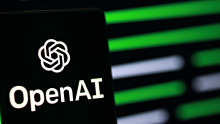ChatGPT4-Questions/User:Darwin2049/Overview
OpenAI - ChatGPT4.
In what follows we attempt to address several basic questions about the onrushing progress with the current focus of artificial intelligence. There are several competing actors in this space. These include OpenAI, DeepMind, Anthropic, and Cohere. A number of other competitors are active in the artificial intelligence market place. But for purposes of brevity and because of the overlap we will limit focus on ChatGPT4 (CG4). Further, we focus on several salient questions that that raise questions of safety, risk and prospects.
Responses. The following links connect to responses to their respective questions:
- Interfacing/Accessibility-Conformability - Synthesis. how will different groups interact with, respond to and be affected by it; might access modalities available to one group have positive or negative implications for other groups;
- Political/Competitive - Synthesis. how might different groups or actors gain or lose relative advantage; also, how might it be used as a tool of control;
- Evolutionary/Stratification - Synthesis. might new classifications of social categories emerge; were phenotypical bifurcations to emerge would or how would the manifest themselves;
- Epistemological - Synthesis how to reconcile ethical issues within a society, between societies; more specifically, might it provide solutions or results that are acceptable to the one group but unacceptable to the other group;
Summary. The links above point to this observer's assessment on how to answer the questions originally;
The links below point to the steps that underpin the answers above. Getting to these answers involved:
- reify the questions: "in other words...": reframe and contextualize the questions;
- sentiment: "so... people are saying...": this meant having a quick glance at the rapidly growing body of reviews and opinions; the resulting observations showed that there is a broad range of sentiment to enthusiasm to panic;
- how does it work: "just push that button!": without getting too deep into the weeds, asking how an LLM works; early uses of the most popular system CG4 showed intrinsic shortcomings that obliged attention; other Deep Learning systems were examined superficially but coverage of their relative features is deferred for another round of analysis;
- risks: "this is great/horrible news!": almost all new technologies involve risk of some sort; these might inherent or organic simply because of their existence or intentionally malicious; past experience provides a framework to speculate about what might come knowing what has been done before; some examples are provided to offer context for further discussion;
- caveats: "however..." : given what is now known about these new capabilities it appeared to be useful to offer some qualifying caveats; these can be expanded upon, dismissed or modified as needed;
- o.k. so far then: "so what if...": have been put forward as a way to approach the more speculative and theoretical prospects of where events may go;
- conclusions - "so... this must mean that...": what do we know now; can we be sure, things are moving fast? can we just say that this is what we believe so far?;
Impressions Sentiments that fell into a few categories:
positive (this is going to be great!), cautious (not so fast!...) (or cautiously worried) or alarmed (it might kill us all!). Geopolitical observers expressed existential threats from rivals - pedal to the metal!;
Operations, Understanding the CG4 internal mechanisms might offer some insight into how it does what it does. And therefore by extension how one group might gain or lose advantage. The result is that several variants of the Deep Learning approach came to light but the Large Language Model (LLM) seemed to be the preferred point of entre'. This was because it has shown itself to be remarkably versatile in its range of applicability.
Risks. Three categories emerged: systemic, malicious and theoretical. In each case our observation is that this new technology is inherently dual use.
That this technology does show itself to be dual use led to the intimation that a pause for some considerations was in order before proceeding. They led to the intermediate synthesis that can be found next.
Intermediate Synthesis Based upon what we have observed
our deliberations suggested that we make more explicit what we think and feel as well as offering some caveats for further consideration.
Caveats Our analysis to this point has suggested that several crucial factors be acknowledged. These include such observations that Deep Learning technology results are dual use. They can be used to further facilitate social, economic and political well being. But they can also be used for malicious purposes that can not yet be imagined.
Phase Shift. Quantum computing is expected to momentarily make its debut by or before the end of the year. IBM will announce availability of its IBM Quantum System Two (EOY 2023). This recently available systems is based on a scalable ensemble of 432 Q-Bit Osprey devices. Migrating Deep Learning systems to a quantum computing environment will result in a quantum computing capability of over 1000 qubits and represents a before/after event.
Theoretical These are speculative. That being so, they attempt to avoid going beyond the bounds of the possible.
Conclusions Synthesis Finally we try to arrive at what supports our position regarding how the question groups were answered. These were the questions on interfaces, political, evolutionary and epistemology.
Note & References The notes and references that follow are intended to provide further support to the theses promoted in this effort.
Back to root page: ChatGPT4-Questions
